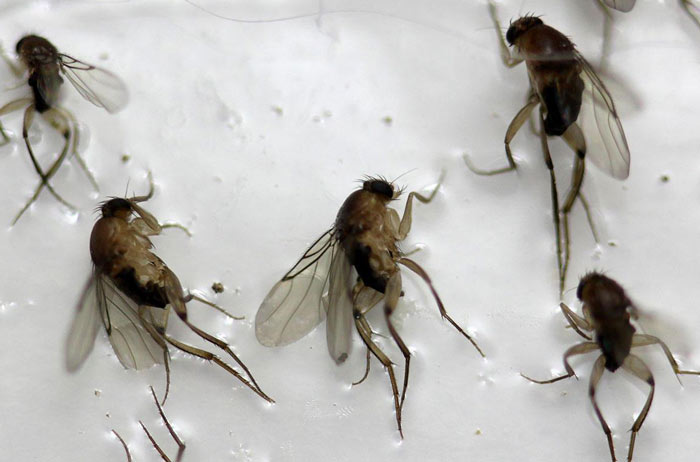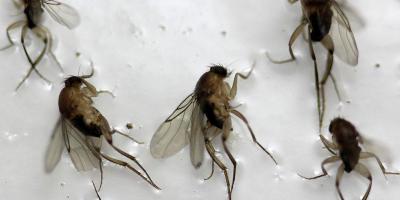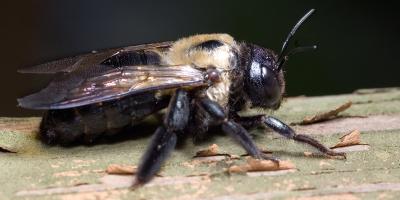Lord of the Flies: How did it get so bad?
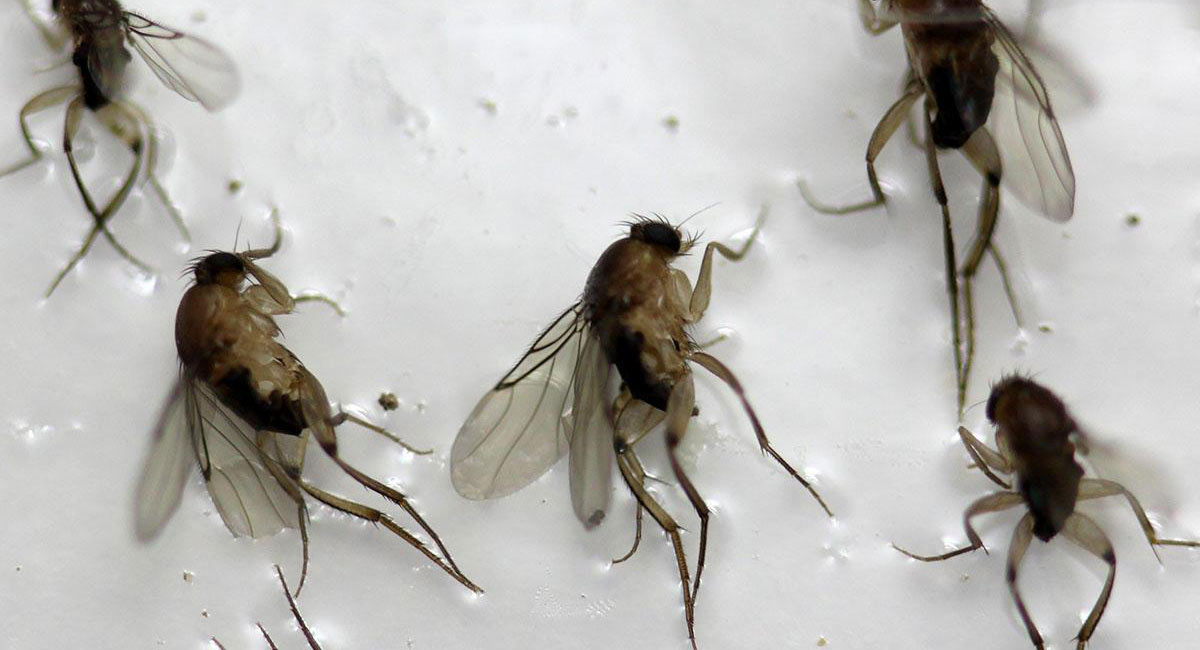
Flies, flies, flies, and more flies! How did they get so bad? Whether in a home or commercial business setting, fly infestations seem to boom overnight. How can that be possible?
This article will focus on the smaller species of structure infesting flies including the fruit fly, fungus gnat, drain flies, and humpbacked flies (phorids). This group of small flies are often commonly confused and misidentified by DIYs and even some licensed pest control operators. Mistaken pest identities lead to wasted pest management efforts and extreme frustration when the fly infestation persists or worsens.
Two of the most encountered small flies are fruit flies and fungus gnats. Drain and humpbacked flies are not as common but can be indicators of serious problems within the home.

Fruit Flies:
By far, the fruit fly (vinegar fly) is the number one small fly encountered in homes and in commercial establishments. Drosophila melanogaster is the common red-eyed fruit fly that we all associated with over-ripened fruit but spoiling fruit isn’t the only food source fruit flies will utilize. Essentially, any solid or liquid food material that ferments is a suitable source for fruit fly breeding.
As summer wears on, fruit flies become more prevalent because locally grown fruits and vegetables are abundantly available. Gardens begin to mature, fruit trees drop their excess fruits, and kitchen counters are well stocked with fresh picked fruits and vegetables. During the ripening process, fermentation takes place and provides a nutrient-rich soft medium for fruit fly egg and larval development.
Getting to the bottom of a fruit fly infestation requires a thorough inspection to identify all possible breeding sources. This includes over-ripened fruits and vegetables (tomatoes, bananas, onions, and potatoes are the most common ones), recycled containers (beer, juice, soda), wet mop heads (with decaying organic debris), drains (with gelatinous build-up), and kitchen equipment (with fermenting liquids and food residues).
Once breeding sources are managed or eliminated, the fruit fly infestation will end. There isn’t much that can be done with insecticides to control these infestations. Adult fly traps are commercially available for DIYs but these items alone will not end the infestation.
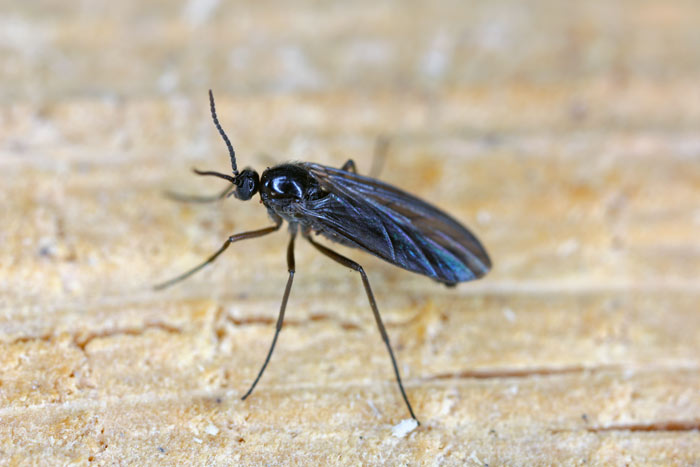
Fungus Gnats:
Fungus gnats are small mosquito-like black flies (they don’t bite) that can be problematic all year long inside homes and commercial offices. Once the fly has been properly identified as a fungus gnat, the places to look for the breeding sites are easily found. Always start with the potted plants as the likely infestation source. Most people, whether at home or in an office setting, overwater plants. When potted plants are consistently overwatered, fungus will begin to grow in the soil and around the roots of the plant, usually in the first 1-2 inches of soil.
If overwatering is identified as the cause, allow the soil to dry out before the next watering cycle occurs. Next, reduce the watering cycle to a lesser frequency.
Indoor winter infestations are common because many outdoor plants were brought into the house with an active fungus gnat infestation. Again, the easy DIY remedy here is to reduce the watering schedule so that the top layer of soil is allowed to dry. Make sure all pots can drain excess water properly. The fungus gnat eggs and larval stages require constant moisture that supports fungal growth for a suitable habitat. Fungus gnats can also occur wherever fungus/mold is growing including bathrooms, drains, basements, and active moisture damage to structures. Repair all structural deficiencies that can cause moisture conditions where mold will grow.
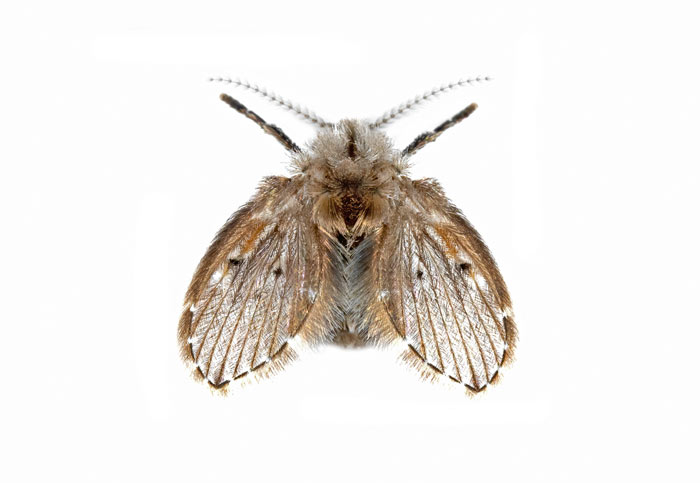
Drain Flies:
Drain flies are also known as moth flies because they resemble tiny moths. Their wings are covered setae (hairs), just like moth wings. Drain fly sightings are always indicative of a sanitation issue with drains anywhere within the home or building but tend to be more common in bathrooms but can be found anywhere with sink traps, stall showers, and floor drains. When drains that are connected to septic/sewer systems dry out, drain flies can make their way into living spaces.
Drain flies seek out drains that have a high-level of organic material build up, and bathrooms are the perfect environment for these conditions because they are frequently used and drains often neglected. Commercial establishments tend to have issues with these flies in public and employee restrooms, floor drains in high use areas, and mop sinks/closets.
Over time, a gelatinous slime layer will begin to build around the drain pipe lining. The slime layer is where the flies lay their eggs and larval development occurs. The slime layer protects eggs and larvae from all kinds of liquid drain cleaners. Bacterial gel materials take time to eat away at the slime layer but are excellent materials to use after the suspect drains have been cleaned.
Drain flies contaminate food and are a health hazard to people because of the germ-laden places they frequent. All drains in suspect areas should be routinely cleaned using a flexible long-handled bristle bush that scours the pipe lining. This is a dirty job, so be sure to protect your eyes, mouth, nose, and hands by wearing protective equipment such as googles, surgical mask, and rubber gloves.
Humpbacked Flies:
Humpbacked flies belong to a group known as Phorid flies. There are many species of Phorids and some are beneficial insects. However, when humpbacked flies appear within a structure, (home or business), this isn’t a good sign, especially if numbers are high. Humpbacked flies are commonly associated with sewage line breaks and leaks. When the line breaks or leaks, it saturates the surrounding soil with raw sewage. Humpbacked flies are attracted to these conditions and begin to lay their eggs.
Because sewage line leaks or breaks are not immediately noticed unless there is a system failure, the flies are able to secretly breed and develop in hidden areas. Once adults begin to emerge, they seek a way out of their dark cryptic development site and follow plumbing lines or emerge through floor cracks, expansion joints, or drains into open spaces. This fly is dangerous when above ground and can contaminate food and food handling surfaces with bacteria from sewage. Additionally, they can contaminate human wounds and sterile environments.
Humpbacked fly management isn’t a DIY endeavor. Once Phorids have been identified by a certified entomologist, a professional pest control operator should be consulted for inspection and recommendations. Other experts in plumbing and construction will likely be involved in any successful Phorid fly elimination plan.
At JP Pest Services, our Professional Service Specialists are very knowledgeable and expertly trained to conduct site inspections that identify pest activity and avert future problems. Our goal, through an Integrated Pest Management (IPM) approach, is to eliminate the current infestation and prevent the next one. The moment you let your guard down, pest invaders seeking food, water, and shelter will fill the void!

